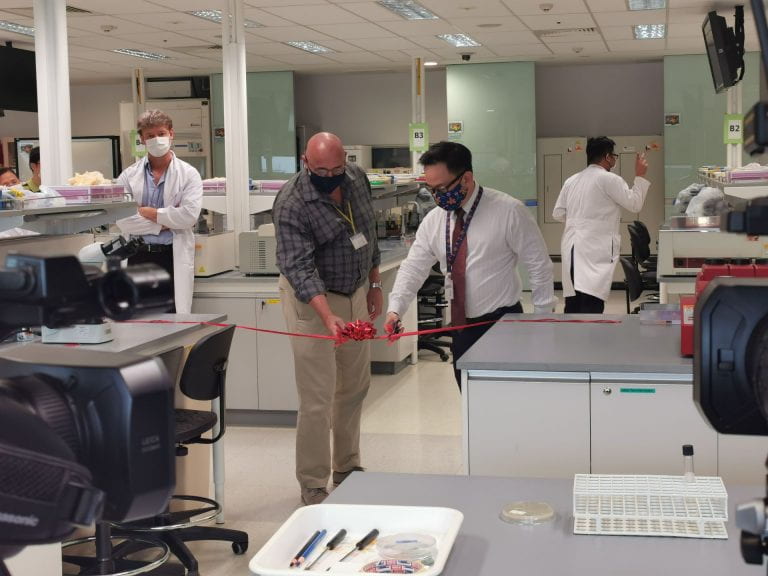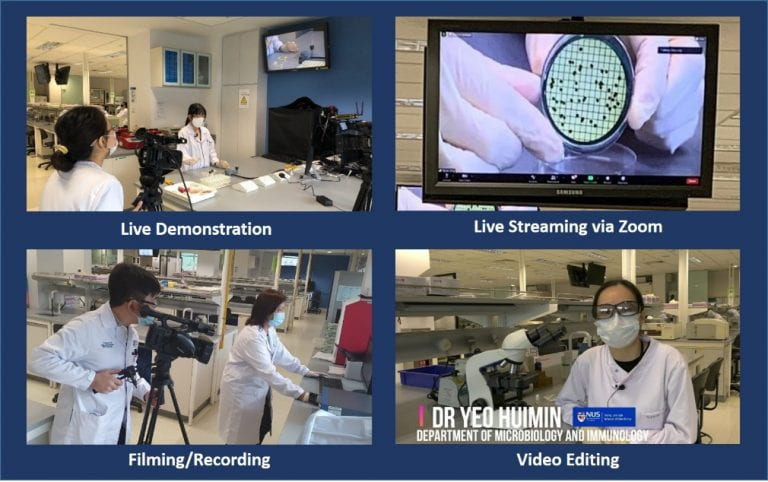CHAN Chuu Ling
Department of Microbiology and Immunology, Yong Loo Lin School of Medicine (YLLSoM)
Chuu Ling shares her team’s experience of setting up and using a filming studio in the laboratory to facilitate blended learning of practical sessions, and how it has changed the way practicals are conducted.

Chan C. L. (2021, Oct 25). Establishing a filming studio in a teaching laboratory: Enhancing teaching practices in the COVID-19 era and beyond.Teaching Connections. https://blog.nus.edu.sg/teachingconnections/2021/10/25/establishing-a-filming-studio-in-a-teaching-laboratory-enhancing-teaching-practices-in-the-covid-19-era-and-beyond/.
Setting up the Department Education Excellence Programme (DEEP) Filming Studio
Figure 1. In this video, the author introduces the DEEP filming studio and describes the impetus for setting it up.
Capabilities of the DEEP Studio
Under the efficient supervision of Dr. Ch’ng Jun Hong, Deputy Head of DEEP, the DEEP studio was set up and ready for use by August 2020. The DEEP studio’s capabilities include performing close-ups of on-screen live demonstrations to students in class, enabling live streaming via Zoom for students both in class and at home, and filming high-quality videos to demonstrate equipment use and experimental techniques (Figure 2). We can easily edit and annotate videos taken using the video-editing studio, which is located on a separate level and equipped with a high-performance computer.

To What Extent has the DEEP Studio Changed Teaching Practices in the Lab?
Previously, the Teaching Assistants (TAs) would gather students (in groups of about 12) to demonstrate microbiological techniques, show them details of microbial cultures, explain experimental procedures, and conduct tutorials. However, with in-person class size restrictions and safe distancing measures being imposed due to COVID-19, such group observations were difficult for the TAs to implement.
To mitigate these issues, we used the DEEP studio to film technical videos and uploaded the footage onto LumiNUS. This had many advantages for students:
- they can view the techniques they need to learn up close;
- they have additional preparation time before coming for class;
- they can review these videos during their revision, and finally
- by filming experiments that are technically simple but long and tedious, students can view the whole process by watching edited videos with clear annotations of the steps and precautions (Figure 3). In this way, they can still visualise the process and experiment results while focusing on the principles and concepts.
We also used the DEEP studio to do live demonstrations on-screen and give practical briefings/tutorials explaining the experiments and their underlying principles. With the cameras zoomed in, students could see details of the techniques even more clearly than during in-person TA demonstrations. Such on-screen live demonstrations had the added benefit of standardising technical demonstrations and information as a more experienced TA could perform this for the entire class. The other TAs would walk around their assigned groups to help individual students with queries or were experiencing technical difficulties. In this way, we combined the benefits of consistent high-quality teaching with personalised attention to each student. Furthermore, filming of live microorganisms was possible with the integrated microscope (Figure 3).
Figure 3. A video clip showing snippets of various videos created for the students to view experiments/techniques performed in practical classes.
Student feedback regarding the DEEP studio was generally positive, and negative comments were mainly related to unfamiliarity and students experiencing technical difficulties with the digital tools, issues which could be rectified with practice. That said, a drawback to this approach was the reduced interaction with students. For example, during live demonstrations and briefings, students were reluctant to speak up when they had to respond to questions posed via the camera. The TA would have to leave the filming area and approach the student seating area to obtain the answers. To address this issue, an iPad was purchased to increase the TA’s mobility while still being able to control and annotate documents digitally. Students also did not have an opportunity to clarify doubts when watching the videos. This made it necessary for the instructors and TAs to set aside time during class to address this or incorporate digital tools like PollEverywhere or Kahoot! to gauge students’ understanding of the content. Additionally, video editing was highly time-consuming but when done well, these edited videos could be used for subsequent classes and would ultimately benefit many cohorts of students.
Concluding Thoughts
In summary, having a recording studio in the laboratory has proven very beneficial for the students, not only during the pandemic but also beyond. Students are encouraged to prepare prior to attending their practicals, with the actual sessions serving as opportunities to clarify doubts and to further reinforce their learning. They can view experimental procedures in greater detail (both live demonstrations and videos) and use the videos for revision. The information given to the entire class can now be standardised, without neglecting the individual student. Furthermore, the reduction in student engagement can be alleviated with some effort on the TA’s part to connect with students, as well as utilising interactive digital tools. Student feedback has been crucial in this whole process and will continue to be sought as we continue refining our teaching practices.
 |
CHAN Chuu Ling is an Instructor from the Department of Microbiology and Immunology at the Yong Loo Lin School of Medicine (YLLSoM). She seeks to excite students about learning and draws joy from seeing students reach their lightbulb moments. She is also interested in learning ways to personalise education and about how technology can change the teaching environment. Chuu Ling can be reached at micccl@nus.edu.sg. |

